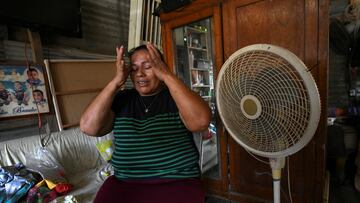HEALTH
What is heatstroke? Causes and symptoms
There is a difference between heat exhaustion and heatstroke. Both are caused by extended periods of day and nighttime temperatures, creating physiological stress on the body.

This week, several US states will be immersed in a heat wave with temperatures expected to hit triple digits. Phoenix, Arizona, generally regarded as the hottest US city has been baking with heat-related deaths hitting new highs. Last year, there were 645 heat-related deaths in Maricopa County - up from 425 the previous year and double the 2020 figure.
Almost two out of three heat-related deaths were aged 50 years or older and 71% occurred on a day where the Weather Service issued an excessive heat warning. And it;s the most vulnerable who are most at risk - almost half of last year’s victims were homeless, many dying inside tents, others succumbing to the heat while out walking, unprotected while the searing sun was at its hottest.
Exposure to heat is increasing, and this trend is set to continue with extreme temperature events increasing in frequency and duration.
Extended periods of day and nighttime temperatures create potentially fatal physiological stress on the human body which exacerbates the top causes of death, including respiratory and cardiovascular diseases.
What is heatstroke?
While heat exhaustion does not usually need emergency medical help if you are able cool down within 30 minutes. If it turns into heatstroke, it needs to be treated as an emergency.
Heat exhaustion is a condition that happens when your body overheats. Symptoms may include heavy sweating, faintness, dizziness and a rapid pulse.
What do do if you have heat exhaustion
- Stop all physical activity, sit down and rest
- Move to a cooler place
- Remove all unnecessary clothing like a jacket or socks
- Drink plenty of cool water or isotonic sports drinks
According to Mayo Clinic, the definition of heatstroke is, “a condition caused by your body overheating, usually as a result of prolonged exposure to or physical exertion in high temperatures. This most serious form of heat injury, heatstroke, can occur if your body temperature rises to 104 F (40 C) or higher”.
Does heatstroke require treatment?
Heatstroke requires emergency treatment and untreated heatstroke can damage the brain, heart, kidneys and muscles. The damage worsens the longer treatment is delayed, increasing the risk of serious complications or death.
Heatstroke symptoms
- High body temperature. A core body temperature of 104 F (40 C) or higher is the main sign of heatstroke
- Change in behavior or mental state. Agitation, slurred speech, confusion, seizures and coma can all result from heatstroke
- Sweating. Skin will feel hot and dry to the touch
- Nausea and vomiting
- Headache
- Rapid breathing. Breathing can become rapid and shallow
- Racing heart rate. Heat stress places burden on heart to help cool body
When to seek medical help
If a person is experiencing heatstroke, seek immediate medical help. Call 911 or your local emergency services number.
Take immediate action to cool the overheated person while waiting for emergency treatment.
- Get person indoors or into shade
- Remove excess clothing
- Cool the person's skin with whatever means available, a cool shower, sponge, spray with a garden hose, sponge with cool water, place ice packs or wet towels on the person’s head, neck, armpits and groin
During periods of extremely hot weather, take measures to safeguard your health and prevent heat exhaustion or heatstroke. These include wearing loose, light-coloured, clothing such as cotton or linen, stay hydrated by drinking more cold drinks - especially if you’re active or exercising, avoid the sun between 11 a.m. and 3 p.m. avoid excess alcohol, avoid extreme exercise and if you are indoors, close curtains and close windows if it’s hotter outside than in your home and turn off electrical equipment and lights that get hot.
Children, older people and people with long-term health conditions (such as diabetes or heart problems) are more at risk of heat exhaustion or heatstroke.
In Phoenix, the Heat Relief Network offers free water with numerous indoor cooling stations, respite centers and hydration stations where people can cool off. Call 2-1-1 to find the nearest free cooling center, find out about opening times or gain heat relief utility assistance.





